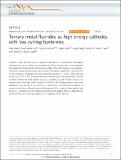| dc.contributor.author | Wang, Feng | |
| dc.contributor.author | Kim, Sung-Wook | |
| dc.contributor.author | Seo, Dong-Hwa | |
| dc.contributor.author | Kang, Kisuk | |
| dc.contributor.author | Wang, Liping | |
| dc.contributor.author | Su, Dong | |
| dc.contributor.author | Vajo, John J. | |
| dc.contributor.author | Wang, John | |
| dc.contributor.author | Graetz, Jason | |
| dc.date.accessioned | 2015-06-08T14:36:15Z | |
| dc.date.available | 2015-06-08T14:36:15Z | |
| dc.date.issued | 2015-03 | |
| dc.date.submitted | 2014-12 | |
| dc.identifier.issn | 2041-1723 | |
| dc.identifier.uri | http://hdl.handle.net/1721.1/97211 | |
| dc.description.abstract | Transition metal fluorides are an appealing alternative to conventional intercalation compounds for use as cathodes in next-generation lithium batteries due to their extremely high capacity (3–4 times greater than the current state-of-the-art). However, issues related to reversibility, energy efficiency and kinetics prevent their practical application. Here we report on the synthesis, structural and electrochemical properties of ternary metal fluorides (M[1 over y]M[2 over 1-y]F[subscript x]: M[superscript 1], M[superscript 2]=Fe, Cu), which may overcome these issues. By substituting Cu into the Fe lattice, forming the solid–solution Cu[subscript y]Fe[subscript 1-y]F[subscript 2], reversible Cu and Fe redox reactions are achieved with surprisingly small hysteresis (<150 mV). This finding indicates that cation substitution may provide a new avenue for tailoring key electrochemical properties of conversion electrodes. Although the reversible capacity of Cu conversion fades rapidly, likely due to Cu[superscript +] dissolution, the low hysteresis and high energy suggest that a Cu-based fluoride cathode remains an intriguing candidate for rechargeable lithium batteries. | en_US |
| dc.language.iso | en_US | |
| dc.publisher | Nature Publishing Group | en_US |
| dc.relation.isversionof | http://dx.doi.org/10.1038/ncomms7668 | en_US |
| dc.rights | Creative Commons Attribution | en_US |
| dc.rights.uri | http://creativecommons.org/licenses/by/4.0/ | en_US |
| dc.source | Nature Publishing Group | en_US |
| dc.title | Ternary metal fluorides as high-energy cathodes with low cycling hysteresis | en_US |
| dc.type | Article | en_US |
| dc.identifier.citation | Wang, Feng, Sung-Wook Kim, Dong-Hwa Seo, Kisuk Kang, Liping Wang, Dong Su, John J. Vajo, John Wang, and Jason Graetz. “Ternary Metal Fluorides as High-Energy Cathodes with Low Cycling Hysteresis.” Nature Communications 6 (March 26, 2015): 6668. © 2015 Macmillan Publishers Limited | en_US |
| dc.contributor.department | Massachusetts Institute of Technology. Department of Materials Science and Engineering | en_US |
| dc.contributor.mitauthor | Seo, Dong-Hwa | en_US |
| dc.relation.journal | Nature Communications | en_US |
| dc.eprint.version | Final published version | en_US |
| dc.type.uri | http://purl.org/eprint/type/JournalArticle | en_US |
| eprint.status | http://purl.org/eprint/status/PeerReviewed | en_US |
| dspace.orderedauthors | Wang, Feng; Kim, Sung-Wook; Seo, Dong-Hwa; Kang, Kisuk; Wang, Liping; Su, Dong; Vajo, John J.; Wang, John; Graetz, Jason | en_US |
| dc.identifier.orcid | https://orcid.org/0000-0002-7200-7186 | |
| mit.license | PUBLISHER_CC | en_US |
| mit.metadata.status | Complete | |
